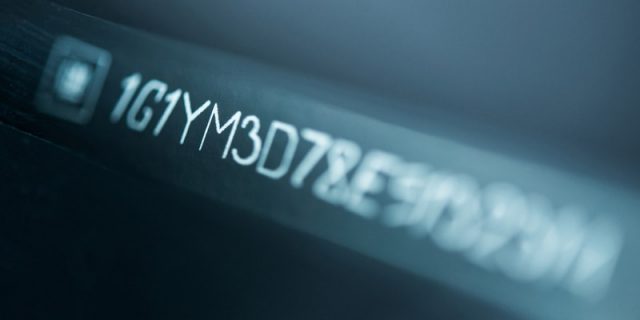
In the United States, automakers began using Vehicle Identification Numbers (VINs) in 1954. In 1981, the National Highway Traffic Safety Administration (NHTSA) standardized VINs to a fixed, 17-character format defined in 49 CFR Part 565.
A VIN functions like a vehicle’s fingerprint. Within regulatory limits, no two vehicles share the same VIN, and the code encodes key details about the vehicle’s manufacturer, attributes, and build. VINs are used for registration, recalls, safety campaigns, and vehicle-history checks.
Where to Find a VIN
You can find a vehicle’s VIN both on documents and on the vehicle itself:
- Documents: title, registration card, and insurance documents.
- On the vehicle: the lower-left corner of the dashboard (viewable through the windshield on the driver’s side); the driver’s door jamb or B-pillar label; and, on many models, stamped or labeled areas in the engine bay (e.g., firewall, radiator support) or on frame rails. Some vehicles also display a label in the trunk area near the spare-tire well.
If you still can’t locate the VIN, contact your dealership or the manufacturer for assistance. Once found, record the VIN in a safe place so it’s available for registration, insurance, or theft recovery.
Brief Review: How to Read a VIN
VIN characters are not random–each position has a defined purpose (letters I, O, and Q are not used to avoid confusion with 1 and 0):
- Characters #1–3 (WMI): World Manufacturer Identifier–region/country, manufacturer, and sometimes vehicle type/division.
- Characters #4–8 (VDS): Vehicle Descriptor Section–model/series, body style, restraint system, engine, and other attributes defined by the manufacturer.
- Character #9: Check digit used to validate the VIN.
- Character #10: Model year code (may differ from the calendar year of manufacture).
- Character #11: Assembly plant.
- Characters #12–17 (VIS): Vehicle Identifier Section–sequential production number that uniquely identifies the vehicle.
For an authoritative decode of basic attributes and recall status, use the official NHTSA VIN Decoder.
U.S. vs. International VIN Standards
If you’re importing, exporting, or just decoding a non-U.S. vehicle, it helps to know where the rules diverge. The United States mandates a specific 17-character format in 49 CFR Part 565, while most other markets follow ISO standards–primarily ISO 3779 (content/structure), ISO 3780 (WMI), and ISO 4030 (location/attachment). Understanding the differences prevents misreads and flags potential fraud early.
- Core Standards: U.S. vehicles use the federal VIN rules in 49 CFR Part 565; internationally, ISO 3779 defines the VIN’s content and structure, ISO 3780 defines the three-character WMI, and ISO 4030 covers how/where the VIN must be marked on the vehicle.
- Check Digit (Position 9): In the U.S. (and Canada), the check digit in position 9 is mandatory and must validate per the federal formula. Under ISO 3779/European practice, a check digit may be optional–so a non-U.S. VIN can be valid even if position 9 isn’t a North American–style check digit.
- Model Year & Plant (Positions 10–11): U.S. VINs explicitly encode model year at position 10 and assembly plant at position 11. ISO 3779 doesn’t require those exact assignments; outside North America, these positions may be used differently within the manufacturer-defined VIS.
- VIS (Positions 12–17) & Low-Volume Rules: In the U.S., large manufacturers typically use the last six characters as a numeric serial; special provisions apply to manufacturers producing ≤ 1000 vehicles of a type (different handling of positions 12–14). ISO leaves VIS usage more flexible, so structure can vary by region/maker.
- Allowed Characters: Both systems use capital letters and digits but exclude I, O, and Q to avoid confusion with 1 and 0–so don’t expect to see those in a legitimate VIN.
- VIN Placement & Visibility: U.S. rules require the VIN to be readable from outside the vehicle through the left side of the windshield (with minimum character height) for most light vehicles. ISO 4030 specifies location/marking generally, but not the U.S.-specific windshield readability requirement.
Practical Takeaway: When checking a non-U.S. VIN, don’t assume the North American check digit or U.S. position-by-position meanings will apply. Validate the WMI via ISO 3780, confirm local structure against ISO 3779, and–if the vehicle will be registered in the U.S.–verify that position 9 computes correctly and that the VIN plate is windshield-readable as required by Part 565. For recalls on U.S.-market vehicles, use NHTSA’s official lookup.
VIN Decoding Services
Beyond make/model basics, a VIN check helps identify prior damage, title brands, odometer issues, open safety recalls, and more–particularly valuable when buying a used vehicle. Because fraud is possible (e.g., swapped or counterfeit labels), compare VINs across multiple locations on the same vehicle and verify that the check digit (position #9) is valid before relying on the code.
You can start with a free decode of core specifications (and check for open recalls) via the NHTSA recall lookup. For a more complete ownership and title-history perspective, run a full vehicle-history report in addition to the basic decode.
Additional Resources
- Wikipedia – Vehicle Identification Number – Background overview of VIN structure and history.
- NHTSA Recall Lookup – Check open safety recalls by VIN.
- 49 CFR Part 565 (eCFR) – U.S. VIN format and content requirements.